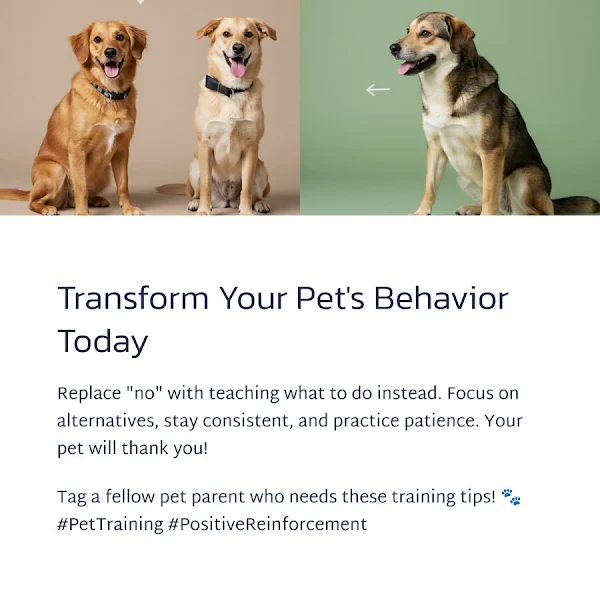Correcting Pet Behavior? You’re Probably Doing It Wrong
Hello~ Everyone, Today I'm talking about pet behavior correction and I have some useful information for you guys~ Shall we find out right away? 😊
Have you ever felt frustrated when your furry friend just won't listen? You're definitely not alone! Many pet owners struggle with behavior issues, but the way we try to fix them might actually be making things worse.
Let's take a closer look at why traditional methods might be failing and what science tells us about effective pet training.
When your dog chews up your favorite shoes or your cat scratches your new couch, your first reaction might be to scold them. But here's the thing - your pet probably doesn't understand what they did wrong!
Animals don't process cause and effect the same way humans do. Your pet might just learn to fear you rather than understand which behavior was inappropriate.
| Common Mistakes | Why They Fail |
| Yelling or scolding after the fact | Pets don't connect punishment with past actions |
| Physical punishment | Creates fear and damages trust |
| Inconsistent rules | Confuses pets about what's allowed |
Our pets aren't tiny humans in fur coats! They have different cognitive processes and motivations that drive their behavior.
Dogs, for example, are naturally social and want to please their pack (that's you!). Cats are independent hunters with strong territorial instincts.
When we understand these natural behaviors, we can work with their instincts rather than against them.
Research consistently shows that positive reinforcement - rewarding good behavior rather than punishing bad behavior - is far more effective for long-term training success.
When your pet does something right, immediately reward them with treats, praise, or play. This creates a clear connection between their action and a positive outcome.
Consistency is key! Make sure everyone in your household follows the same training approach so your pet doesn't get confused by mixed signals.
Did you know that your pet's memory for specific actions is incredibly short? For effective training, you need to reward or redirect within seconds of the behavior.
If you find chewed shoes but your dog chewed them hours ago, it's too late for a training moment. Instead, focus on prevention and setting your pet up for success.
Remember: From your pet's perspective, there's no such thing as "getting revenge" or "being spiteful" - they're just responding to their environment and previous learning.
Now that we understand the principles, let's look at how to apply them to everyday situations. The key is to think about what you want your pet to do, not just what you want them to stop doing.
For example, instead of punishing a dog for jumping on guests, teach and reward an alternative behavior like sitting when people arrive.
Prevention is powerful! If your cat scratches furniture, provide attractive scratching posts and temporarily cover furniture with materials cats don't like to scratch.
| Behavior | Instead of... | Try this! |
| Barking | Yelling "No!" | Teaching "quiet" command with treats |
| Chewing | Scolding after finding damage | Providing appropriate chew toys |
| Jumping | Pushing dog down | Rewarding "four on the floor" |
| Scratching | Declawing or punishment | Multiple scratching posts, positive reinforcement |
| Potty accidents | Rubbing nose in mess | Consistent schedule, immediate outdoor rewards |
| Counter surfing | Yelling when caught | Keep counters clear, teach "leave it" |
| Digging | Punishment after finding holes | Designated digging area with buried treasures |
| Begging | Occasionally giving in | Never feed from table, reward lying on bed during meals |
| Leash pulling | Yanking back | Stop walking when pulling, reward loose leash |
| Aggression | Punishing growls | Identify triggers, work with professional trainer |
| Fearfulness | Forcing exposure | Gradual desensitization, positive associations |
| Separation anxiety | Punishment for destruction | Gradual alone time, enrichment toys |
How long does it take to change a pet's behavior?
It depends on the behavior, how long it's been practiced, and your consistency! Simple behaviors might improve in days, while complex or long-standing issues might take months. The key is patience and consistency.
Is it true that you can't train adult pets?
Absolutely not! This is a harmful myth. While puppies and kittens may learn more quickly, adult pets are completely capable of learning new behaviors. In fact, their longer attention spans can sometimes make training easier!
When should I seek professional help?
Consider working with a certified animal behaviorist or positive-reinforcement trainer if your pet shows aggression, extreme anxiety, self-harming behaviors, or if behavior problems are affecting your relationship with your pet.
Remember that patience and consistency are your best tools when working with your furry friends. Every pet is an individual with their own personality and learning style, so be prepared to adjust your approach to find what works best.
The most important thing is maintaining a loving relationship with your pet throughout the training process. Our pets bring so much joy to our lives - they deserve our understanding and patience in return! 💖
See you next time with another helpful pet topic! 🐾 Bye Bye~






Comments
Post a Comment